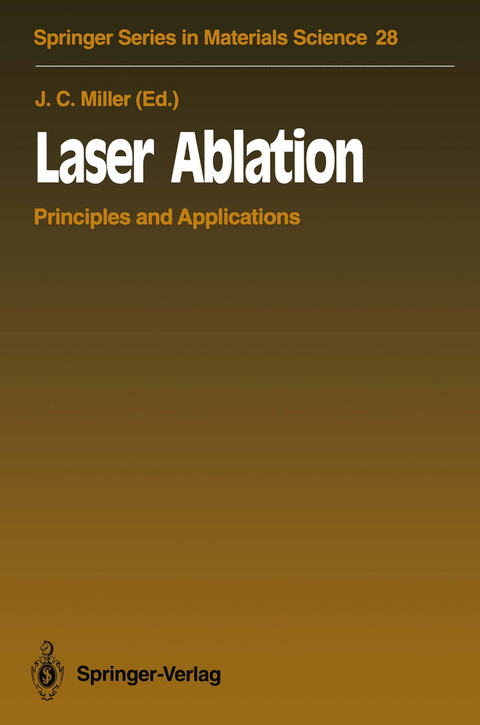
Laser Ablation
Springer Berlin (Verlag)
978-3-642-78722-5 (ISBN)
Laser Ablation discusses experiments and models for laser ablation of atoms, ions, molecules and clusters from solid surfaces. Specific topics include laser ablation and thin-film deposition of high-temperature superconductors; laser-induced desoption of adsorbed molecules and of semiconductors; laser ablation of polymers and biological tissues; laser desorption mass spectrometry of biological molecules; fundamental physics of ablation; and such diverse applications as tribological film deposition laser-ablation mass spectrometry in ion traps.
1. History, Scope, and the Future of Laser Ablation.- 1.1 Introduction.- 1.2 History of Laser Ablation Studies and Applications.- References.- 2. Electronic Processes in Laser Ablation of Semiconductors and Insulators.- 2.1 Electronic Mechanisms in Desorption and Ablation.- 2.2 Interaction of Photons with Solids.- 2.3 Electron-Lattice Interactions and the Localized Excited State.- 2.4 Creation and De-Excitation of the Localized Excited State.- 2.5 Survey of Experimental Results.- 2.6 Models of Laser-Induced Desorption.- 2.7 Simulation of Laser Ablation.- 2.8 Summary and Conclusions.- References.- 3. Laser Ablation and Optical Surface Damage.- 3.1 Introductory Remarks.- 3.2 Characteristics of Optical Surface Damage.- 3.3 Possible Causes of Optical Damage.- 3.4 Investigation of Optical Surface Damage Mechanisms.- 3.5 Concluding Remarks.- References.- 4. Pulsed-Laser Deposition of High-Temperature Superconducting Thin Films.- 4.1 Advantages of Pulsed-Laser Deposition.- 4.2 Materials Base.- 4.3 Laser-Beam-Target Interaction.- 4.4 Dynamics of the Laser-Produced Plume.- 4.5 Evaporant-Substrate Interaction.- 4.6 Frontiers of High-Temperature Superconducting Thin-Film Research.- 4.7 Scaling-up to Larger Areas.- 4.8 Future Directions.- 4.9 Summary.- References.- 5. Interaction of Laser Radiation with Organic Polymers.- 5.1 History.- 5.2 Characteristics of UV-Laser Ablation.- 5.3 Chemical Physics of the Ablation Process.- 5.4 Theories of Ultraviolet-Laser Ablation.- 5.5 Contemporary Trends in UV-Laser Ablation.- References.- 6. Laser Ablation and Laser Desorption Techniques with Fourier-Transform Mass Spectrometry (FTMS).- 6.1 Principles of FTMS Operation.- 6.2 Laser-Ablation FTMS for Clusters.- 6.3 Laser-Desorption FTMS for Biomolecules.- 6.4 Future Directions.- 6.5 Conclusions.- References.- 7. Diagnostic Studies of Laser Ablation for Chemical Analysis.- 7.1 Laser Ablation in Vacuum.- 7.2 Laser Ablation in an Atmosphere.- References.
| Erscheint lt. Verlag | 8.12.2011 |
|---|---|
| Reihe/Serie | Springer Series in Materials Science |
| Zusatzinfo | XII, 187 p. |
| Verlagsort | Berlin |
| Sprache | englisch |
| Maße | 155 x 235 mm |
| Gewicht | 317 g |
| Themenwelt | Naturwissenschaften ► Chemie ► Analytische Chemie |
| Naturwissenschaften ► Physik / Astronomie ► Atom- / Kern- / Molekularphysik | |
| Naturwissenschaften ► Physik / Astronomie ► Festkörperphysik | |
| Schlagworte | Ablation • biomolecules • Desorption • Laser • Materials • semiconductor • spectroscopy • Surface • Thin Films |
| ISBN-10 | 3-642-78722-3 / 3642787223 |
| ISBN-13 | 978-3-642-78722-5 / 9783642787225 |
| Zustand | Neuware |
| Haben Sie eine Frage zum Produkt? |
aus dem Bereich


